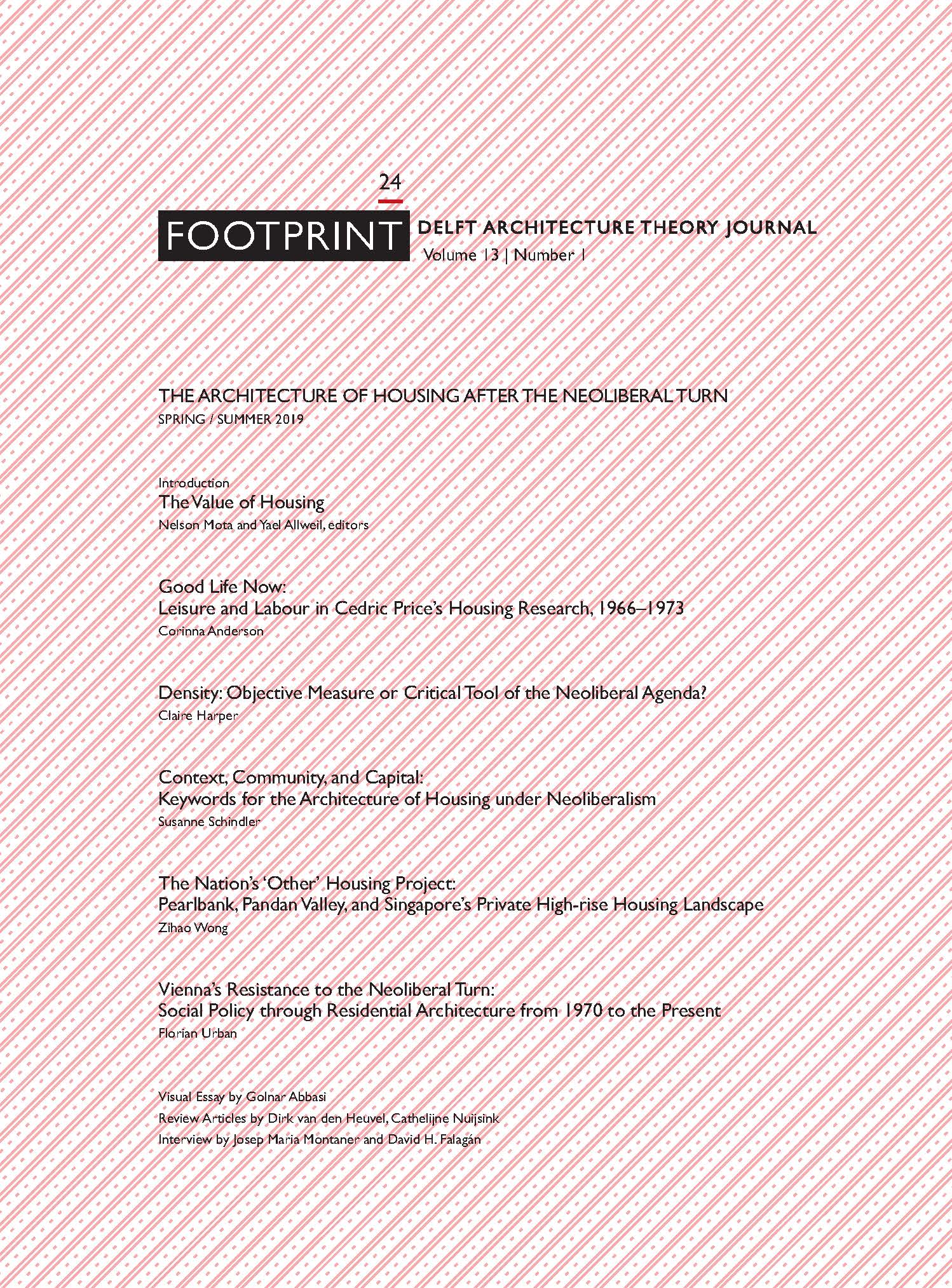House Vision
Architects and Industry Awakening ‘House’ Desires and Visualising New Ways of Living
DOI:
https://doi.org/10.7480/footprint.13.1.3629Abstract
The design of the detached house has been at the core of architectural developments in post-Second World War Japan and the subject of a lively discussion among architects about what makes a good home at a particular moment. Alongside the continuous production of houses, architects actively proposed new ways of living that contrasted with what was increasingly becoming a uniform housing stock based on mass fabrication. However, the intensification of neoliberal policies after a decade of severe economic crisis in the 1990s drove architects towards social involvement once again, initiating a housing trend based on sharing, renovation and re-use of the existing housing stock. This essay will highlight the work of the House Vision think-tank and full-scale building exhibitions – initiated in 2011 by Japanese designer and art director Kenya Hara – as one response to the socio-economic and political conditions after the neoliberal turn. Similar to the efforts of independent architects in recent decades, House Vision aims to generate awareness in society about alternatives to mainstream housing options. Yet what makes this initiative different is that it is not an individual effort but a collaborative project between designers and industries to push the latest technologies in home electronics, energy and mobility devices into new architectural forms.
References
Anne Allison, Precarious Japan (Durham: Duke University Press, 2013)
Zygmunt Bauman, Liquid Life (Polity Press, 2005)
Amy Beth Borovoy, The Too-Good Wife (Berkeley: University of California Press, 2005).
Jean-Louis Cohen, The Future Of The Architecture, since 1889 (London: Phaidon, 2012)
Jean-Louis Cohen, Architecture In Uniform (Paris: Hazan, 2011).
Edan Corkill, ‘Awakening the Desire for a Home with Personality.’ The Japan Times. 3 March 2013. https://www.japantimes.co.jp/life/2013/03/06/lifestyle/awakening-the-desire-for-a-home-with-personality/
Ray Forrest and Yosuke Hirayama, “The Financialisation of the Social Project: Embedded liberalism, neoliberalism and home ownership”, Urban Studies, 52, no. 2 (2015): 239
Ray Forrest and Yosuke Hirayama, “The Uneven Impact Of Neoliberalism On Housing Opportunities”, International Journal Of Urban And Regional Research 33, no. 4 (2009): 998-1013, doi:10.1111/j.1468-2427.2009.00903.x.
Ryūichi Hamaguchi, [ヒューマニズムの建築 : 日本近代建築の反省と展望 ] “Hyūmanizumu No Kenchiku” (Tōkyō: Ondorisha, 1947).
Kenya Hara, and House Vision Executive Committee,「House Vision 2, 2016 Tokyo Exhibition」, Tokyo: Bijutsu Shuppansha, 2016.
Kenya Hara, and House Vision Executive Committee, 「House Vision 2013 Tokyo Exhibition」, Tokyo: Heibonsha, 2013.
House Vision website. http://house-vision.jp/en/exhibition.html
Yosuke Hirayama, “Reshaping The Housing System: Home Ownership As A Catalyst For Social Transformation”, in Housing And Social Transition In Japan (London: Routledge, 2007), 20-22.
Taro Igarashi,「3.11からの建築家の動き」 “3.11kara no kenchikuka no ugoki” (Initiatives by Architects Since 3.11), The Japan Architect 84 (Yearbook 2011), no. 4 (2012):6.
Toyo Ito and Nikolaus Hirsch,‘Toyo Ito Reconstruction and Ideology’. https://www.e-flux.com/architecture/positions/212685/reconstruction-and-ideology/ Accessed on 24 January 2019.
Toyo Ito,「あの日からの建築」”Ano hi hara no kenchiku”. Tokyo: Shūeisha, 2012.
Toyo Ito, “Postscript” in Koolhaas, Rem, and Hans-Ulrich Obrist. Project Japan: Metabolism Talks, 697. Köln: Taschen, 2011
Cameron Allan McKean, ‘Kenya Hara: The Future of Design’. The Japan Times online, 4 January 2014. https://www.japantimes.co.jp/life/2014/01/04/style/kenya-hara-future-design/#.XFLqxC2ZM0o
Atsushi Miura,「第四の消費 : つながりを生み出す社会へ」Daiyon no shōhi :tsunagari o Umidasu Shakai e (Tokyo: Asahi Shimbun Shuppan, 2012), translated by Dana Lewis as The Rise of Sharing: Fourth-Stage Consumer Society in Japan (Tokyo: International House of Japan, 2014).
Osamu Nishiyama,「笑う住宅」”Warau Jūtaku” (Tokyo: Chikuma Shobo, 1995)
Cathelijne Nuijsink “What is a House? Architects Redesigning the Domestic Sphere in Contemporary Japan, 1995-2011”. PhD Dissertation. The University of Pennsylvania. August 2017.
Emiko Ochiai, The Japanese Family System In Transition. A Sociological Analysis Of Family Change In Postwar Japan (Tokyo: LTBC International Library Foundation, 1997).
Ken Oshima, “Postulating The Potential Of Prefab: The Case Of Japan”, in Home Delivery: Fabricating The Modern Dwelling (Basel: Birkhäuser, 2008), 33.
Richard Ronald and Allison Alexy, Home And Family In Japan (repr., London: Routledge, 2011).
Richard J. Samuels, 3.11; Disaster And Change In Japan (Ithaca: Cornell University Press, 2013).
Yoshiyuki Sato,「新自由主義へのミクロな抵抗」“Shinjiyūshugi e no mikurona teikō” (A Micro-Resistance to Neoliberalism) in Yoshiyuki Yamana, Seiichi Hishikawa, Masaki Uchino, and Masatake Shinohara「En [縁]:アート・オブ・ネクサス」’En: āto obu nekusasu’ (En: Art of Nexus), 146-146. Tokyo: Toto Publishers, 2016.
Tsuchiya, Sadao. 「House Vision の始まり」 House Vision no hajimari, 172. (House Vision 2013 Tokyo exhibition). Tokyo: Heibonsha, 2013.
Sawako Shirahase, Demographic Change And Inequality In Japan (Melbourne: Trans Pacific Press, 2011).
Chizuko Ueno, The Modern Family In Japan (Melbourne: Trans-Pacific Press, 2009).
Masahiro Yamada, 「パラサイト・シングルの時代」 Parasaito Shinguru no Jidai (Tokyo: Chikuma Shobou, 1999).
Additional Files
Published
Issue
Section
License
- Authors retain copyright and grant the journal right of first publication with the work simultaneously licensed under a Creative Commons Attribution License that allows others to share the work with an acknowledgement of the work's authorship and initial publication in this journal.
- Authors are able to enter into separate, additional contractual arrangements for the non-exclusive distribution of the journal's published version of the work (e.g., post it to an institutional repository or publish it in a book), with an acknowledgement of its initial publication in this journal.




